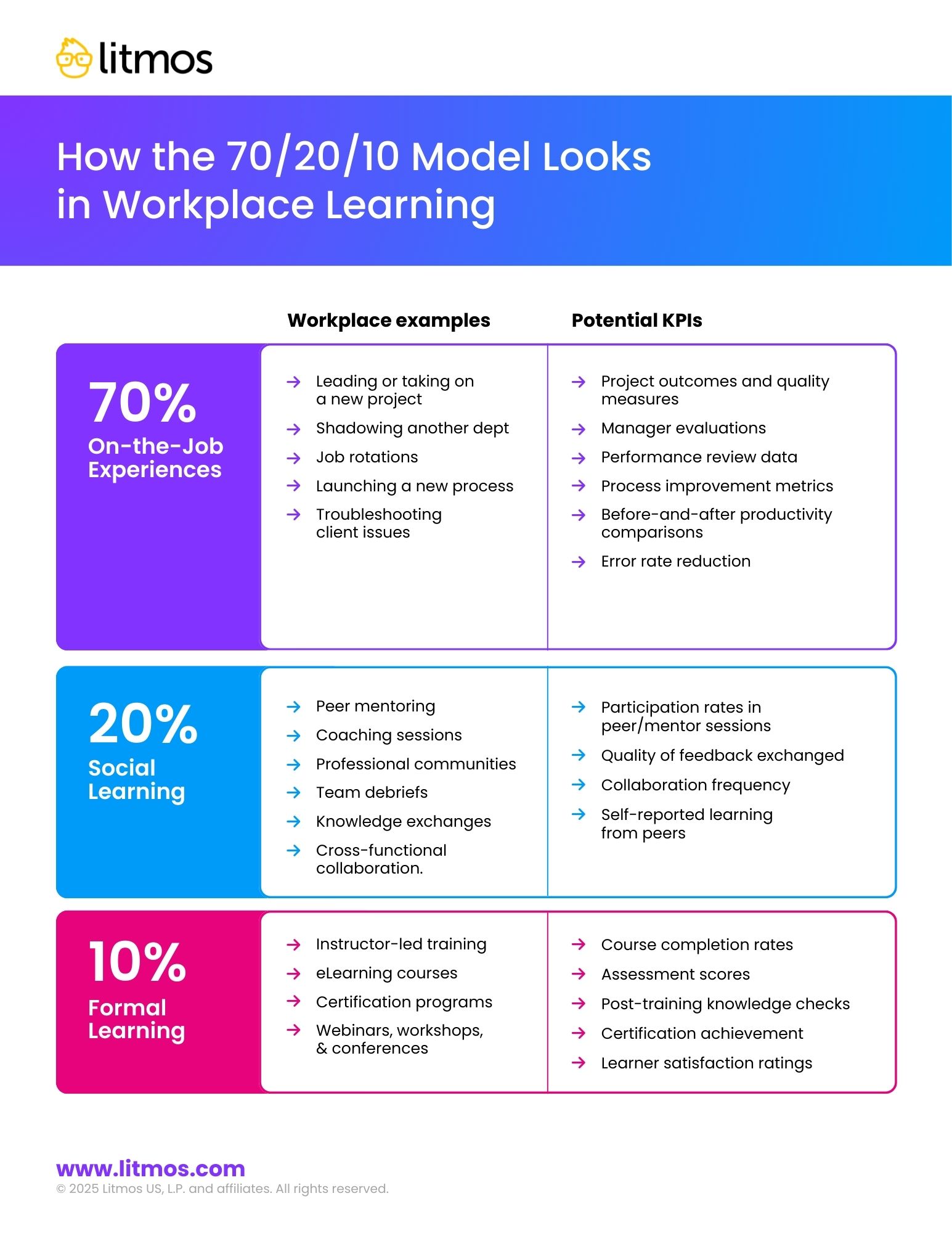What is the 70/20/10 Model? This Framework Could Make a Major Impact on Your L&D Program
In many organizations, workplace learning has traditionally meant formal training programs such as classroom sessions, eLearning modules, and workshops. While these experiences have value, they only represent a fraction of how people truly develop skills and knowledge on the job. The 70/20/10 model offers a more holistic perspective, helping L&D professionals design initiatives that leverage the full spectrum of workplace learning opportunities.
The 70/20/10 framework originated from research conducted by Morgan McCall, Michael Lombardo, and Robert Eichinger at the Center for Creative Leadership in the 1980s. Through interviews with successful executives, they found that people tend to learn:
- 70% from on-the-job experiences, tasks, and problem-solving
- 20% from interactions with others, such as coaching, mentoring, and feedback
- 10% from formal learning, such as courses and structured training
Although these percentages are not meant to be prescriptive, they underscore the idea that the majority of development happens outside the traditional classroom or formal training space. For L&D professionals, this shift transforms their role from content creators to architects of learning ecosystems that integrate experience, social learning, and structured training.
Why the 70/20/10 Model Matters for L&D
The value of this model lies in its recognition that workplace learning is continuous, contextual, and embedded in day-to-day work. Employees often develop the most relevant skills while actively tackling challenges, collaborating with colleagues, and reflecting on outcomes. A well-designed learning strategy aligned to 70/20/10 ensures that formal training is reinforced with real-world application and peer-based learning.
Instead of thinking of the model as a strict ratio, L&D professionals should see it as a guide for balancing different learning opportunities. For example, a new project manager may attend a formal leadership course (10%), receive regular coaching from a senior leader (20%), and take on a high-visibility project managing a cross-functional team (70%). Each component reinforces the others, creating a richer and more durable learning experience.
Examples of 70/20/10 in Workplace Learning Environments
The image below outlines workplaces examples of the 70/20/10. If you’d like to have your own copy of this cheatsheet, you can download it by clicking the link or image below.
To explore examples of on-the-job learning, social learning, and formal learning and which KPIS you can use to measure the success of these modes of learning in the workplace, download the free 70-20-10 Cheat Sheet here.
One of the biggest challenges with the 70/20/10 framework is that the majority of learning, particularly the 70% gained through on-the-job experiences and the 20% from social interactions, happens outside traditional, trackable training environments. Unlike formal courses, which have clear attendance records, assessments, and completion data, experiential and social learning are more fluid and less visible. Measuring their impact often requires indirect methods such as manager feedback, self-reflection journals, project outcomes, or performance reviews. Even then, it can be difficult to isolate whether skill improvements came directly from these informal experiences or a combination of factors.
For L&D professionals, this means moving beyond course completion metrics and adopting broader evaluation strategies that capture behavior change, collaboration patterns, and real-world application of knowledge over time.
How to Apply the 70/20/10 Model to Your L&D Program
Applying the 70/20/10 model isn’t about abandoning formal training; it’s about extending learning beyond the classroom so that employees use and deepen what they’ve learned in authentic contexts. Here are four tips for integrating 70/20/10 into your workplace strategy:
- Designing for Application. Too often, training stops at knowledge transfer. The 70% portion of the model reminds us that application is where the real development happens. This means structuring post-training assignments, projects, or challenges that require learners to use their new skills immediately. For example, after a negotiation skills workshop, participants could be assigned to lead a real negotiation with support from a mentor who can provide feedback afterward.
- Encouraging Peer and Mentor Interaction. The 20% component thrives in environments where feedback and knowledge sharing are valued. L&D can facilitate this by creating peer learning groups, communities of practice, or mentorship programs. When learners share experiences and advice, they not only reinforce their knowledge but also create a culture where learning is an ongoing, shared responsibility.
- Making Formal Learning a Launchpad. The 10% should not be isolated events; they should act as a catalyst for the other 90%. This might involve building learning pathways where a course is followed by peer coaching or integrating case studies from the workplace into training discussions so employees see immediate relevance.
- Leveraging Technology to Connect the Pieces. Digital tools can bridge the gap between formal and informal learning. A learning platform could host training resources, discussion boards, and project-sharing spaces, allowing learners to access materials as needed and exchange insights in real time. For remote or hybrid teams, these platforms also make it easier to track progress and maintain momentum after a course ends.
By using the 70/20/10 model as a guiding framework, L&D professionals can design learning strategies that are richer, more integrated, and more aligned with how people grow in their roles. Rather than being limited to isolated training events, workplace learning becomes a continuous, collaborative process that is embedded in the flow of work where it’s most likely to stick.
Measuring Informal Learning’s Impact
Learning leaders are at an impasse. To get a seat at the table, we need to measuring impact, not just delivery. Yet only 26% of organizations continuously track learning outcomes, and only 11% track learning needs.
I recently sat down with learning experts from Litmos and Fosway to discuss how L&D can close the maturement gap. In it, we discuss the vital importance of that 70% – informal learning – and how tough it can be to demonstrate the value of it. Looking for insights on measuring demonstrating L&D’s impact? Watch “Pull Up a Chair: Securing L&D Leaders a Seat at the Table” here.





